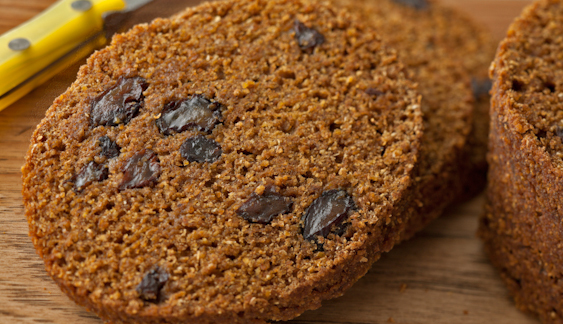Boston Brown Bread

introduction
Brown bread descends from thirded breads, rustic farm breads made of coarse grain meals and mineral-rich sweeteners—hearty, rural fare that fortified against cold temperatures and calorie depletion, following in the tradition of foods related to work.
This recipe features three exceptional products from Anson Mills: sweet, crunchy coarse cornmeal; fragrant, tweedy graham flour; and spicy Italian heirloom rye. Most brown bread is sweet and flabby—you can taste the molasses, but none of the grains. Not so here: this bread is remarkably moist—but pleasantly scratchy at the same time—rich, vaguely tart, and absolutely wild with flavor. It is a superb companion to baked beans, of course, but toasted, buttered, and taken with a cup of black tea laced with milk, it makes a simple and profoundly satisfying repast. Cream cheese? Yes! Jelly? Yes! Even peanut butter glides smoothly over this bread.
Historical Notes
Before the American Revolution, farms from New England to Georgia produced landrace grains brought from Europe, grains selected over centuries for flavor, resistance to drought and disease, and ability to make consistently good crops in poor soils. Farmers also quickly assimilated Native American corn selected for the same qualities into their grain farming as well. Thus corn, wheat, rye, and beans grew together—often in the same field—along with cane and pumpkins.
Rustic breads of mixed grain meals and flours formed an early American baking tradition. One early form of brown bread (quick bread sweetened with molasses) was called “rye and injun” and included equal parts—or “thirds”—of cornmeal, rye meal, and whole wheat flour mixed with water and stewed pumpkin for sweetening. Rye and injun was a crude yeasted bread, served with beans in both the North and South.
After our Revolution, pearlash-leavened thirded bread became popular throughout the Colonies, particularly one known today as Boston brown bread. Since that time, the bread’s fundamental elements have not changed: rye meal, cornmeal, and graham flour mixed with water—later milk or buttermilk—and molasses and baked in a mold. There are hundreds of variations on classic thirded bread, but the basic elements of rye, wheat, corn, cane, and pumpkin appear in different iterations throughout the vast scape of recipes over the last four centuries.
equipment mise en place
For this recipe, you will need a teakettle for boiling water; two small coffee cans, each about 4 inches in diameter and about 5½ inches high; a medium mixing bowl; a whisk; a large mixing bowl; a wooden spoon; aluminum foil; a Dutch oven or small, deep roasting pan that can hold the cans and enough water to come halfway up their sides; and a cooling rack.
-
-
Vegetable oil spray
-
16ounces (2 cups) low-fat buttermilk
-
5.7ounces (½ cup) light molasses
-
2ounces (about ¼ cup packed) dark brown sugar
-
¾teaspoon fine sea salt
-
5ounces (1 cup) Anson Mills Abruzzi Heirloom Rye Flour
-
5ounces (scant 1 cup) Anson Mills Rustic Coarse Graham Wheat Flour
-
5ounces (1 cup) Anson Mills Coarse Yellow Cornmeal or Coarse White Cornmeal
-
2teaspoons baking soda
-
½teaspoon baking powder
-
4.5ounces (1 cup) dark raisins
-
-
Adjust a rack to the middle position and heat the oven to 350 degrees. Fill a teakettle with water, bring the water to a boil, and then turn off the burner. Spray the inside of 2 small coffee cans (each about 4 inches in diameter and about 5½ inches tall) with vegetable oil spray and set them aside.
-
Combine the buttermilk, molasses, brown sugar, and salt in a medium mixing bowl. Whisk until the sugar dissolves and the mixture is homogenous. Combine the rye flour, graham flour, cornmeal, baking soda, and powder in a large mixing bowl and whisk well. Pour the buttermilk mixture into the dry ingredients and stir with a wooden spoon until no lumps remain. Fold in the raisins. Divide the batter evenly between the prepared coffee cans, cover the cans with pieces of aluminum foil sprayed with vegetable oil spray, and set the cans in a Dutch oven or small, deep roasting pan. Bring the water in the teakettle back to a boil and pour enough water into the pot or pan to come about halfway up the sides of the cans. Place in the oven and steam the breads until they have risen and are firm, about 1 hour and 50 minutes.
-
Remove the pot or pan from the oven and transfer the cans to a cooling rack. Remove the foil and let the loaves cool in the cans for 5 minutes. Gently shake each can to loosen the bread from the sides and invert the loaves onto the rack, easing them out of the cans. Stand the loaves upright and let cool to room temperature. To serve, slice the loaves crosswise into rounds. Wrap leftovers tightly in foil and store at room temperature for up to 1 week.